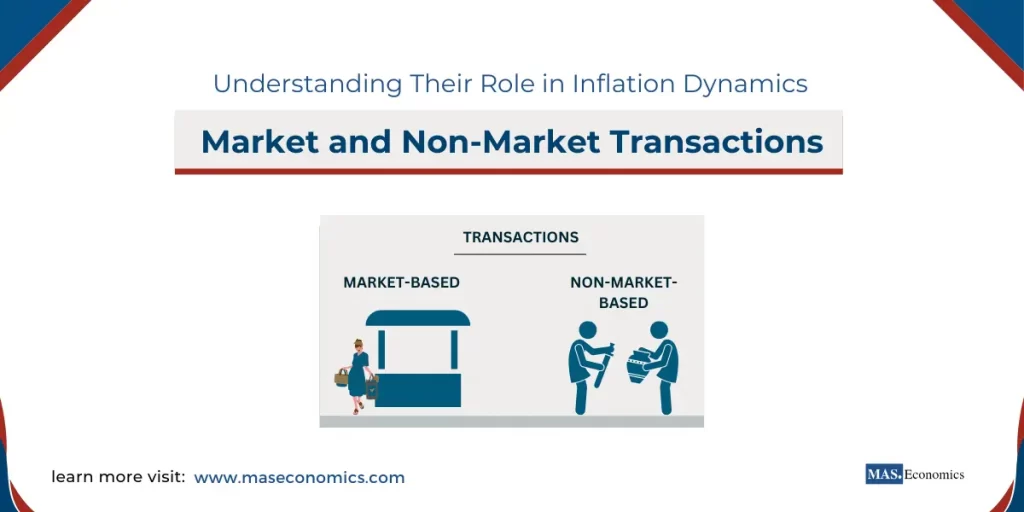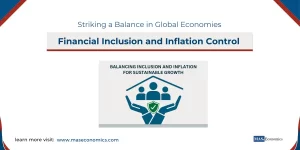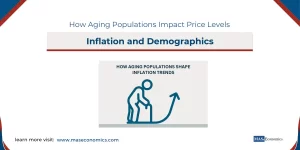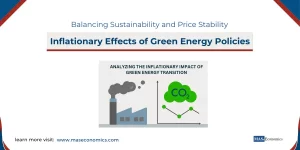Traditional economic discussions often focus on market transactions—activities like buying groceries, paying for services or investing in assets—which dominate our understanding of economic dynamics. However, there exists another significant dimension: non-market transactions. Activities such as bartering, informal services, and community exchanges play a vital role in the broader economy and contribute meaningfully to inflation dynamics.
Understanding the distinctions between market and non-market transactions and their respective influences on inflation is essential, particularly in economies with substantial informal sectors. Examining how non-market activities affect price levels sheds light on inflation’s broader origins and challenges conventional assumptions.
Market-Based Transactions
Market-based transactions are the bread and butter of most economic systems. These are transactions involving money as a medium of exchange, where goods or services are exchanged for currency—whether it’s dollars, euros, or yen. Market transactions are often categorized by the use of money, the presence of a market for buying and selling, and the ability of individuals to negotiate freely for the best price.
How Market Transactions Affect Inflation
In market-based economies, inflation is commonly examined through the relationship between the money supply and the availability of goods and services. When the money circulating in the economy increases relative to available products, inflation becomes more likely. This interaction between supply and demand is a fundamental driver of price levels.
On the demand side, when households and businesses have more disposable income, they tend to spend more, increasing demand for goods and services. If production cannot scale up accordingly, prices begin to rise—a reflection of inflation driven by heightened demand. Fiscal policies, like tax cuts or subsidies, can amplify this effect by further increasing disposable income and stimulating consumption.
Conversely, on the supply side, rising production costs—whether due to higher wages, increased material costs, or supply chain disruptions—lead businesses to pass these costs onto consumers. This process results in higher prices, as producers adjust to the cost pressures of their transactions with suppliers and other market players.
These market transactions are systematically recorded in national accounts, providing a transparent way to monitor inflation trends. However, in economies where a substantial share of economic activity occurs outside formal markets, inflation measurement becomes more challenging, as these activities elude standard tracking mechanisms.
Non-Market-Based Transactions
Non-market-based transactions, often overlooked, involve exchanges that do not fit within the traditional definitions of a monetary economy. These can be bartering arrangements, informal services, or coerced exchanges that occur without a formal currency-based market setting. Non-market transactions can have unique effects on the economy that are harder to quantify but still highly impactful.
Bartering and Informal Exchanges
Bartering is one of the oldest forms of economic exchange—swapping one good or service for another. While bartering might seem archaic in today’s world, it still plays a significant role in informal sectors, especially in rural areas or underdeveloped regions.
Take, for example, an informal arrangement where farmers exchange crops for labor. Such transactions, though not formally recorded, have direct implications for the supply of agricultural produce. If a rise in bartering occurs due to high inflation in currency-based transactions, this affects the availability of goods in formal markets. Consequently, fewer goods in the formal market could push prices higher, creating an indirect link between non-market transactions and inflationary pressures.
In urban areas, informal service exchanges—such as babysitting between neighbors, favors for rent reductions, or labor exchanged for other household services—serve a similar function. When non-market activities become more dominant in response to high prices in formal markets, the structure of supply and demand in the market system changes, influencing inflation in both obvious and subtle ways.
Forced and One-Sided Transactions
Non-market transactions aren’t always voluntary or mutually beneficial. They can also occur in situations where power dynamics create a coerced exchange. A notable example includes labor camps or situations of bonded labor, where individuals are forced to work under a ruling power in exchange for mere survival. These transactions don’t follow typical market mechanisms, but they significantly alter labor availability and wage dynamics, potentially keeping wages artificially low in formal markets.
For example, if a substantial part of the workforce is tied up in non-market labor like unpaid family labor or forced labor, the available labor pool in the formal economy shrinks. This can lead to rising wages for formal jobs, a labor cost that businesses are likely to pass on to consumers, resulting in cost-push inflation.
Inflation and the Overlap Between Market and Non-Market Transactions
The distinction between market and non-market activities may seem clear-cut, but the reality is far more intertwined. One directly influences the other, often in unexpected ways.
Case Study: Subsidies and Informal Markets
Government policies like subsidies can serve as a bridge between market and non-market economies. Imagine a government providing agricultural subsidies to support farmers during a poor growing season. These subsidies directly affect the formal market by ensuring food prices remain stable. However, they also indirectly impact informal markets.
With subsidies in place, farmers might use part of the additional financial cushion to engage in barter exchanges or provide community labor. The presence of these informal activities ensures that, even if formal markets are stable, informal prices might differ, reflecting the underlying imbalances in supply and demand. In such cases, inflationary pressures might still persist, but they manifest in the informal segments of the economy that remain unseen in national economic metrics.
The Role of Informal Credit
Another important aspect to consider is informal lending. In economies with less developed banking sectors, many rely on informal credit networks. The interest rates in these networks often fluctuate wildly, depending on supply and demand for cash. During times of tight monetary policy or high inflation, individuals who cannot access formal credit lines turn to informal lenders who might increase their rates. This creates a feedback loop where high-interest costs drive more people into informal transactions, making inflation harder to combat.
Non-Market Transactions in Inflation Dynamics
The impact of non-market transactions on inflation becomes more evident when considering economies with a significant informal sector. In such economies, non-market exchanges often make up a substantial portion of economic activity.
The Shadow Economy’s Impact on Inflation
The shadow economy—which includes unregulated economic activities ranging from black-market trading to informal work—acts as a buffer during inflationary periods. When prices rise in formal markets, individuals often turn to the informal economy to fulfill their needs at lower costs, effectively sidestepping official price increases.
However, this shift also has broader implications for inflation:
Distorted Price Signals
With a significant portion of transactions happening outside the regulated market, the demand in formal sectors drops, creating misleading signals for policymakers. This can lead to delayed or inappropriate responses to inflation, further exacerbating price instability.
Demand Spillovers
On the other hand, non-market transactions can spill over into market transactions, especially in commodities like food and fuel. When food prices in informal markets rise, they create pressures on formal market prices as well, given the interconnectedness of supply sources.
Challenges in Measuring Inflation
With so many transactions occurring in informal settings, accurately measuring inflation becomes problematic. The official Consumer Price Index (CPI) may not reflect the true price levels experienced by consumers who are heavily involved in non-market exchanges. Thus, the actual inflation experienced by individuals may be much higher or lower than reported figures, depending on their reliance on informal transactions.
Addressing Both Market and Non-Market Realities
Understanding the role of non-market transactions in inflation provides policymakers with a broader perspective when tackling inflationary pressures. Traditional monetary policies, which focus on controlling money supply and interest rates, often fall short when a significant part of the economy operates outside the bounds of the formal market.
Integrative Approaches to Inflation Management
To address inflation effectively, it is crucial to consider policies that target both market and non-market sectors. A few key strategies could include:
Improving Transparency in Informal Sectors
Formalizing parts of the informal economy can lead to better monitoring and regulation. This might include policies that encourage informal businesses to register or provide benefits to workers previously operating in non-market conditions, such as extending social security or health insurance.
Targeted Subsidies and Direct Cash Transfers
Instead of generalized subsidies, which can spill over into informal markets, targeted interventions—such as direct cash transfers—can help manage demand in both market and non-market settings. This can alleviate the inflationary impact while supporting the most vulnerable.
Monitoring Informal Interest Rates
Since informal credit plays a significant role in non-market transactions, policies aimed at reducing dependence on such high-interest lending could help stabilize inflation. Extending microcredit or improving access to banking can diminish reliance on informal lenders, thereby reducing the inflationary impact of interest rate fluctuations.
Conclusion
Market and non-market transactions are not isolated from one another; they form a complex web of economic exchanges that impact inflation in significant ways. While market-based transactions are easy to monitor, understand, and regulate, non-market transactions operate in the shadows, influencing demand, prices, and economic stability more subtly.
A comprehensive understanding of inflation requires policymakers to look beyond conventional market indicators and consider the role of non-market activities. Recognizing the effects of bartering, informal labor, and informal lending, among other practices, is essential for developing a holistic approach to managing inflation effectively.
FAQs:
What is the difference between market and non-market transactions?
Market transactions involve formal exchanges where money is used to buy goods or services, while non-market transactions occur without money, often as bartering, informal services, or community exchanges. Non-market transactions impact economic activity but are harder to measure within traditional inflation metrics.
How do market transactions drive inflation?
Market transactions drive inflation through demand-pull and cost-push mechanisms. Demand-pull inflation occurs when high consumer demand outpaces supply, increasing prices. Cost-push inflation arises when production costs rise, prompting businesses to raise prices to maintain profit margins.
Why do non-market transactions matter in understanding inflation?
Non-market transactions indirectly influence inflation by affecting supply and demand in formal markets. As people turn to non-market options during high inflation, demand in the formal market may decrease, impacting prices and overall inflation levels.
How does bartering impact inflation?
Bartering allows people to avoid high costs in formal markets during inflation, decreasing demand for certain goods in the market. This can tighten the supply in formal markets, potentially driving up prices and creating inflationary pressures.
How do subsidies affect inflation in both market and non-market transactions?
Subsidies lower costs for consumers or producers in formal markets but can drive demand in informal markets as well. For instance, agricultural subsidies may lead to overproduction, which can impact prices across both formal and informal sectors.
What are the inflationary effects of informal lending?
In economies where banking access is limited, informal lending networks with high interest rates can contribute to inflation. As borrowing costs rise, consumers’ purchasing power erodes, creating additional pressure on both formal and informal markets.
How do non-market activities challenge the measurement of inflation?
Since non-market transactions are often unrecorded, they can distort inflation measurements like the Consumer Price Index (CPI), which mainly reflects formal market prices. This means the actual inflation felt by those using non-market exchanges may be different than official figures suggest.
What policy measures help address inflation in economies with large informal sectors?
Policymakers can target inflation in economies with large informal sectors by formalizing informal activities, improving access to formal credit, and using targeted subsidies or cash transfers to stabilize demand in both market and non-market settings. This approach helps manage inflation across the whole economy.
Thanks for reading! Share this with friends and spread the knowledge if you found it helpful.
Happy learning with MASEconomics




